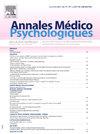Comparaison de caractéristiques sociales et cliniques en fonction du sexe chez des personnes ayant un trouble de la personnalité du groupe B
IF 0.5
4区 医学
Q4 PSYCHIATRY
引用次数: 0
Abstract
Introduction
In the field of Cluster B personality disorders (PDs), studies have primarily focused on borderline personality disorder (BPD), predominantly including women. Moreover, studies comparing various Cluster B PDs have examined some clinical features between men and women, particularly symptoms, without considering social characteristics.
Objectives
This study aims to compare the social and clinical characteristics of women and men with Cluster B PDs, using a database from a specialized service for persons with a PD.
Methods
Clinical variables examined included the severity of psychopathology as assessed by clinicians and perceived PD symptoms. These were measured using validated tools and entered into the service's database. Social variables included for example marital status and social network, and were systematically collected upon entry into the service. Additionally, therapy goals, part of the initial assessment, were qualitatively compared.
Results
Socially, there was no statistically significant difference between men (n = 103) and women (n = 283) regarding marital status, education, source of income, and number of leisure activities. Men had a more limited social network than women (P < 0.001). According to the Borderline Personality Questionnaire (BPQ), more women scored in the BPD diagnostic range compared to men (P < 0.001). Analysis of BPQ dimensions showed that women exhibited more dissociative symptoms (P = 0.04). Also, the proportion of women reporting substance use in the last month was significantly higher (P = 0.04). Regarding therapy goals, improving relationships with oneself and others was most common among women, while men's goals mainly focused on managing symptoms and activities of daily life (e.g., finding a job, adopting healthier lifestyle habits).
Conclusion
This study contributes to considering sex and gender in service provision for people with Cluster B PDs. While there are several similarities between men and women, some social differences support the addition of interventions targeting everyday life elements, such as lifestyle habits for men.
B组人格障碍患者的性别社会和临床特征比较
在B类人格障碍(pd)领域,研究主要集中在边缘型人格障碍(BPD),主要包括女性。此外,比较各种B类pd的研究检查了男性和女性之间的一些临床特征,特别是症状,而没有考虑社会特征。目的:本研究旨在利用PD患者专业服务的数据库,比较B类PD患者的社会和临床特征。方法临床变量包括临床医生评估的精神病理严重程度和PD症状。这些都是使用经过验证的工具测量的,并输入到服务数据库中。社会变量包括婚姻状况和社会网络等,在进入服务时系统地收集。此外,作为初始评估的一部分,治疗目标进行了定性比较。结果在社会方面,男性(n = 103)和女性(n = 283)在婚姻状况、教育程度、收入来源和休闲活动数量方面无统计学差异。男性的社交网络比女性更有限(P < 0.001)。根据边缘性人格问卷(BPQ),与男性相比,女性在BPD诊断范围内得分更高(P < 0.001)。BPQ维度分析显示,女性表现出更多的解离症状(P = 0.04)。此外,报告上个月使用药物的女性比例显著较高(P = 0.04)。关于治疗目标,改善与自己和他人的关系在女性中最为常见,而男性的目标主要集中在管理症状和日常生活活动(例如,找工作,采用更健康的生活习惯)。结论本研究有助于在为B类pd患者提供服务时考虑性别因素。虽然男性和女性之间有一些相似之处,但一些社会差异支持针对日常生活因素(如男性的生活习惯)增加干预措施。
本文章由计算机程序翻译,如有差异,请以英文原文为准。
求助全文
约1分钟内获得全文
求助全文
来源期刊

Annales medico-psychologiques
医学-精神病学
CiteScore
1.30
自引率
33.30%
发文量
196
审稿时长
4-8 weeks
期刊介绍:
The Annales Médico-Psychologiques is a peer-reviewed medical journal covering the field of psychiatry. Articles are published in French or in English. The journal was established in 1843 and is published by Elsevier on behalf of the Société Médico-Psychologique.
The journal publishes 10 times a year original articles covering biological, genetic, psychological, forensic and cultural issues relevant to the diagnosis and treatment of mental illness, as well as peer reviewed articles that have been presented and discussed during meetings of the Société Médico-Psychologique.To report on the major currents of thought of contemporary psychiatry, and to publish clinical and biological research of international standard, these are the aims of the Annales Médico-Psychologiques.
 求助内容:
求助内容: 应助结果提醒方式:
应助结果提醒方式:


